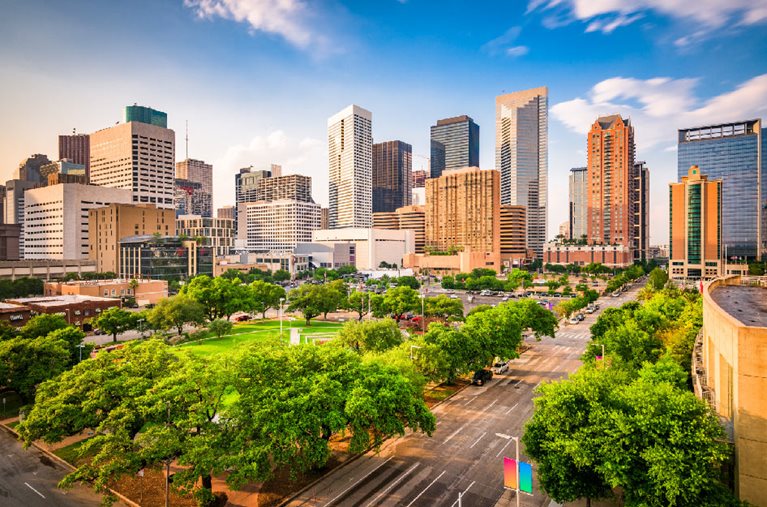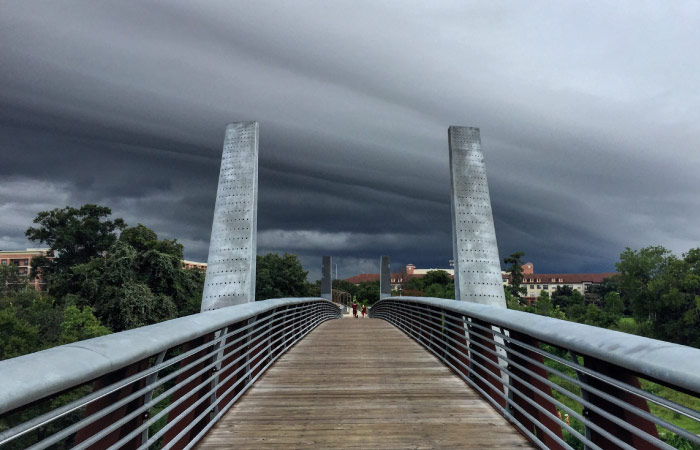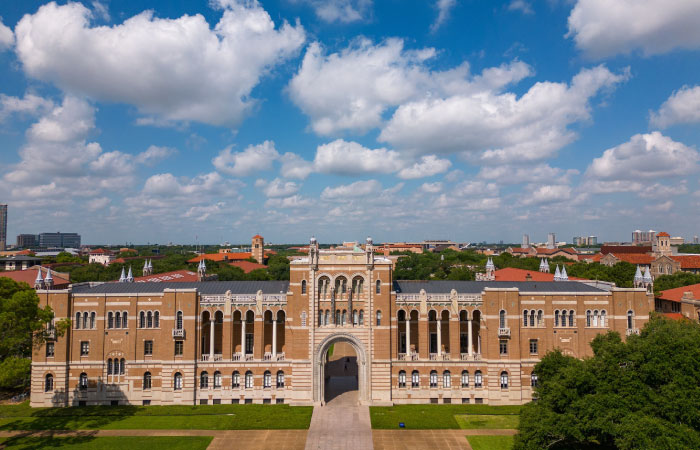
What Are the Pros and Cons of Living in Houston, Texas?
Houston Texas
If you’re ready for a change of scenery, the thriving city of Houston, TX, may have just what you’re looking for. Houston is one of the most populous cities in the nation, and while the city’s growth levels may not be exponential right now, its suburban areas are singing a different tune. So, no matter if you’re a young professional wanting to experience the best of city life or a family looking for the best schools, parks, and housing prices, you’re probably curious about the pros and cons of living in Houston. What’s life in Houston, Texas, really like? Is Houston a good place to live? Is it the right place for you? To help you make your decision, here’s our list of what we think you should know about living in Houston, Texas.
| Moving to Houston? Start by getting a quote from PODS. |
Fun Facts About Living in Houston, Texas
- H-Town is the fourth most populous city in the U.S., with 2.3 million people.
- The city is named after Sam Houston, who led Texas’ battle for independence from Mexico.
- Houston’s Texas Medical Center is the largest life sciences destination in the world.
- The Galleria in Houston is the largest shopping mall in Texas.
- There are 14 major colleges and universities in Houston.
- The Houston Livestock Show and Rodeo is the biggest rodeo in the world.
Pros and Cons of Living in Houston, Texas — FAQs
Q: Is Houston a good place to live in?
A: Millions of people agree that even though there are pros and cons of living in Houston, Texas, the benefits outweigh the disadvantages! Perhaps because Houston has a lower cost of living, lots of job opportunities, and a great entertainment scene — just to name a few perks.
Q: Why is Houston so cheap to live in?
A: The overall cost of living in Houston (e.g., housing, food, transportation) is lower than the national average and the averages in many other major cities.
Q: What is a livable salary in Houston?
A: According to MIT’s Living Wage Calculation, a livable salary for a single person in Houston is around $43,300 before taxes.
Q: What's the safest area to live in Houston?
A: Sugar Land and Bellaire are considered to be two of the safest places to live in the Houston area.
These Are the Essential Pros and Cons of Living in Houston, Texas
Ready to dive into what makes Houston so great (and sometimes not so great)? Here are 13 pros and cons of living in Houston.

One of the biggest pros of living in Houston, Texas, is the relatively low cost of living.
1. Pro: The Houston Cost of Living is Low.
Often, when people are weighing the pros and cons of living in Houston, they’re the most interested in financial information. One of the biggest pros of living in Houston, Texas, is that it has a relatively low cost of living — especially when you consider that it’s the fourth most populous city in the U.S. It has a 96.9 cost of living score, about three percent lower than the national average of 100.
The Cost of Living in Houston vs. Other Texas Cities
Houston isn’t the only popular city in Texas, though, which leaves many people wondering, “Is Dallas or Houston better? And what about Austin?” While Austin has a population less than half that of Houston, its cost of living is much higher at 129.1. The cost of living in Dallas is a bit more reasonable at 100.2, despite having 1 million fewer residents than Houston.The Cost of Living in Houston vs. Other Texas Cities
When you look at average home values in these big Texas cities, it becomes apparent how closely they relate to the cost of living (and how much further your dollar will go in Houston!).
- Average home value in Austin: $514,200.
- Average home value in Dallas: $305,600.
- Average home value in Houston: $264,900.
|
Dallas vs. Austin vs. Houston Pros and Cons When it comes to Dallas vs. Austin vs. Houston pros and cons, cost of living is typically the big one. However, it’s definitely not the only factor to consider when choosing a new city to call home. Be sure to also think about your lifestyle and the things that are most important to you, for example:
All of these cities, however, deal with extremely hot summers with high heat indices and humidity levels. |
2. Con: Houston Has High Sales and Property Taxes.
A low cost of living and no state income taxes are pretty big selling points. So, what are the cons of Houston? It’s worth noting that there are higher sales and property taxes in Houston. The sales tax for the state of Texas is 6.25 percent; however, counties and cities can also add in sales tax, and for Houston, that brings it to 8.25 percent total sales tax. Most food items are exempt from sales tax, but things like pet products, paper products, clothing, books, and personal care items, among others, are taxed. What’s more, property taxes in Harris County are at 1.77 percent, compared to the 0.90 percent national average (ouch!).
3. Pro: Houston’s Job Market Is Healthy and Diverse.
Not only does Houston have a lower cost of living than cities like Austin and Dallas, but it also has a thriving job market. There are lots of oil and gas industry jobs available, as it’s one of the major employment industries in the city. Companies like Chevron, ConocoPhillips, and Occidental Petroleum are all headquartered in Houston. But it isn’t just about the oil! There are plenty of engineering, research, and other science-related jobs in Houston, thanks to companies like NASA, Hewlett Packard, and Sysco. And employment opportunities in the service industry and hospitality sector are also plentiful, due to Houston's popularity as a tourist destination.

Hurricanes and tropical storms along the Gulf Coast can cause significant rain in Houston.
4. Con: Life in Houston, Texas, Sometimes Means Dealing With Extreme Weather.
One of the worst things about living in Houston is the chance for extreme weather. Houston is on a floodplain, which means there is a chance of severe flooding when there is heavy rain. Hurricanes and tropical storms along the Gulf Coast bring a risk of rain and flood damage, like from Hurricane Ike in 2008 and Hurricane Harvey in 2017. Harris county is also a hotspot for tornadoes.
As for summers, they can be very hot and humid, and for some folks with respiratory issues, this can be difficult to deal with. From June to September, temperatures can reach into the 90s and 100s with high humidity.
However, most of the year, you can enjoy more pleasant weather in Houston — including mild winters with only small chances of ice precipitation. And while the summer season has intense heat, the remaining part of the year from October to May is very mild, with highs in the 60s and 70s and lows that don’t hit below the 40s.
5. Pro: Houston Is Known for Its Amazing Entertainment Scene.
Another one of the major pros of living in Houston is that there’s always something fun to do. Because the city is so diverse, there’s a variety of activities that appeal to people of all interests. You’ll find classic Texas pastimes, like the Houston Livestock Show and Rodeo, and cultural attractions, like the Lynn Wyatt Square for the Performing Arts, the Bayou Music Center, and the Houston Grand Opera (all located in Houston’s Theater District). For a fun day out with the kids, be sure to visit the Houston Zoo and the Children’s Museum Houston.You can always find live music or other community activities like yoga and Zumba in one of Houston’s many parks, and if you want to explore Houston’s variety of cultures, don’t miss the Black History Month Culture Fest, the Indian Film Festival of Houston, and the Houston Latin Fest.

There are lots of private universities in the city with higher tuition rates, including private schools like Rice University (pictured), Houston Christian University, and the University of St. Thomas.
(Source: Rice University via Facebook)
6. Con: Private Education in Houston Can Be Expensive.
There are numerous private schools in Houston that you can choose to send your kids to, but it’s important to note that private education sometimes comes with a high price tag. The tuition costs vary depending on what suburb or neighborhood the school is in, but if this is something you’re interested in, be prepared to include a significant new line item on your family’s budget.
There are also lots of private universities in the city with higher tuition rates, including private schools like Rice University, Houston Christian University, and the University of St. Thomas.
|
Pros and Cons of Living in Houston, Texas: University of Houston Instead of attending an expensive private college, you could always attend the public University of Houston. Some of the pros of this school include its highly ranked education program, research centers, and city campus. Its cons are that parking can be difficult, classes tend to fill up fast, and some neighborhoods around campus are prone to flooding. |
7. Pro: Houston’s Close to Other Major Texas Cities.
While there’s plenty to do and see in Houston, it’s also nice to know you have options when it comes to day trips or extended weekends in a new city. One of the most popular places for folks to visit — especially in the hot summers — is the coastal city of Galveston, which is only about an hour away. You can be chilling on the Gulf in no time, enjoying a change of scenery at the beach.
Houston is also relatively close to Austin (3 hours), San Antonio (4 hours), and even Dallas (4 hours). That means you can visit any of these fun cities for the weekend (or check out smaller towns along the way) without having to book a flight or take extra days off of work.
8. Con: Houston Has a Higher-Than-Average Crime Rate.
As with many large urban areas, answering safety-related questions like, “Is Houston dangerous?” can be challenging. While Houston does have a crime rate that’s higher than the national median, that rate is on the decline in several key areas. Also, there are many safe neighborhoods in Houston that have tons of amenities and are appealing to families. These include Kingwood Area, Addicks Park Ten, and Lake Houston.
Houston has a lot of vibrant neighborhoods and safe suburbs to call home.
(Source: Visit The Woodlands via Facebook)
9. Pro: Houston Has Some Great Areas To Call Home.
Houston has a lot of vibrant neighborhoods and safe suburbs to call home. No matter what you’re looking for, Houston is bound to have an area that appeals to your situation and needs.
For Retirees
If you want a safe suburb that has a slower pace of life and lots to offer retirees, you can’t go wrong with DeCordova or West Lake Hills, both ranked by Niche as some of the best places to retire in Texas.For Families
If you want to settle down and raise a family, or if you’re moving to Houston with the kids in tow, you definitely want to check out all the amenities that places like The Woodlands and Cinco Ranch offer — whether it’s A+ schools, outdoor activities, or fun places to explore on the weekends.For Young Professionals
Moving to Houston for a job and want to be at the heart of all the action? Young professionals have been flocking to neighborhoods like Fourth Ward, Midtown, and Neartown-Montrose, where they’re close to coffee shops, parks, and some fantastic bars and restaurants.
10. Con: Houston Isn’t Known as a Walkable City.
What about the pros and cons of living in Houston for someone who prefers walking or taking public transportation to driving a car? If you’re moving from a pedestrian-friendly city like New York or Chicago, you may be disappointed by this one.
One of the major cons of a city the size of Houston is that it isn’t very walkable outside of the central business district and the city center of downtown. Different Houston neighborhoods and suburbs themselves are very walkable, with green spaces to enjoy, but it’s hard to walk anywhere in between. Since the city was set up to accommodate drivers and cars, there are lots of well-designed interstates that connect the various parts of the city, but it’s just not feasible to walk. There are buses and a rail system, but residents find that their routes are limited. If you’re moving to Houston from a very walkable city like New York, Philadelphia, or Chicago, this may take some getting used to — especially the traffic congestion that comes with all the cars.

The Houston Astros are just one of several pro sports teams that call H-Town home.
(Source: Houston Astros via Facebook)
11. Pro: There’s an Awesome Pro Sports Scene in Houston.
If you’re a sports fan or you’re coming from a sports-centric city, chances are you want to root for your new hometown’s teams. In Houston, you’re in luck, because you have a lot of choices:
- The Houston Astros (MLB)
- The Houston Rockets (NBA)
- The Houston Dynamo FC (MLS)
- The Houston Texans (NFL)
You’ll find it’s easy to start following any of these professional sports teams, but don’t forget about the college teams at local schools like Rice University and the University of Houston, with lower ticket prices and even more sports to watch!
12. Con: The Houston Housing Market Can Be Competitive for Buyers.
While the average home value in Houston is about 25% lower than the national average, Houston is considered a neutral market, which means there are opportunities for buyers and sellers alike. Some sources consider the market to be leaning slightly in favor of sellers due to limited inventory creating a more competitive market for buyers. However, mortgage interest rates are high, despite current rate cuts, which keeps some interested parties from considering a new home purchase.
13. Pro: There’s a Great Foodie Scene in Houston.
Residents of Houston rave about the food scene, and it really is one of the best in the country. Because there are so many different cultures that call Houston home, you’ll find new restaurants popping up all the time. You’ll not only find Korean, Vietnamese, Mexican, and Indian restaurants all around you, but they’re also incredibly affordable. And don’t forget about Texas BBQ — Houston is home to some of the best around. Whether you want to find a hole-in-the-wall restaurant, a food truck, or a five-star, sit-down restaurant, you can expect that the quality of food will always be top-notch.Houston Foodies Love:
Is Living in Houston, Texas, Right for You?
Hopefully, this guide has given you a clear picture of the pros and cons of living in Houston. H-Town certainly has a lot going for it — low cost of living, warm weather, lots of cultural cuisine, and a thriving job market. And while there are disadvantages to living in any city, Houston’s pros outweigh its cons for most, especially those looking to find an affordable place to live where there’s always something fun to do.
If you’ve decided that living in Houston is right for you, let PODS help you get there! Have a portable moving and storage container delivered right to your driveway where you can pack and load on your own schedule. One month of storage is built into every PODS move, so you don’t have to feel rushed. Once it’s loaded, your container will be picked up and transported to your new home in Houston, or you can store it at a secure PODS storage center until you’re ready to unload.
Editor’s note: For ease of reading, average home values were rounded to the nearest $100.
Related Articles
Comments
Leave a Comment
Your email address will not be published. Required fields are marked *

